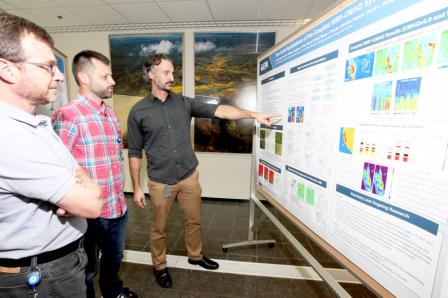Community Multi-scale Air Quality (CMAQ) Modeling System for Air Quality Management
What is the Community Multi-scale Air Quality (CMAQ) Modeling System?
CMAQ is a powerful computational tool used for air quality management. It simultaneously models multiple air pollutants including ozone, particulate matter and a variety of air toxics to help air quality managers determine the best air quality management scenarios for their communities, regions and states. The tool can provide detailed information about air pollutant concentrations in any given area for any specified emission or climate scenario.
What are the benefits of using CMAQ?
CMAQ delivers fast, scientifically sound estimates of ozone, particulates, toxics and acid deposition. It analyzes air quality as a whole by including state-of-the-science capabilities for modeling multiple air quality issues and multi-scale capabilities for urban and regional scale air quality modeling. Its modular design allows for inclusion of new science in the model to address increasingly complex air pollution issues.
Who should use CMAQ?
The CMAQ modeling community has thousands of users in over 50 countries and includes researchers, regulators, consultants, and forecasters in government, academia and the private sector. Both EPA and states use CMAQ for air quality management. States also use CMAQ to assess implementation actions needed to attain National Ambient Air Quality Standards. Air quality regulators use CMAQ to give a clear picture of how to implement pollution controls. The National Weather Service uses CMAQ to produce daily U.S. forecasts for air quality.
How does CMAQ work?
The CMAQ modeling system links meteorological models, emissions models and an air chemistry-transport model, allowing users to use it for predicting the fate and transport of multiple air pollutants and for generating air quality estimates for communities, states and regions.
CMAQ Updates
In October 2016, EPA released CMAQ version 5.2 (beta) to the public, encouraging feedback on potential improvements. A final version is scheduled for release in June 2017. This newest version of the modeling system includes three major scientific advances, additional diagnostic capabilities, and several minor modifications and bug fixes.
The major new features of CMAQ version 5.2 include new treatment of organic aerosols, new windblown dust model, and a new gas-phase chemical mechanism. The new organic aerosol treatment and wind-blown dust model address deficiencies in earlier versions of CMAQ. CMAQ version 5.2 also includes several new instrumented diagnostic capabilities that allow users to probe source-receptor relationships.
How can I get help?
CMAQ is available for download from the Community Modeling and Analysis System (CMAS) website and through GitHub, linked below. EPA instituted the CMAS website in 2001 to provide community air quality modeling support, sharing of ideas and techniques through communication, and to encourage the growth of the community. It is currently operated under contract by the University of North Carolina at Chapel Hill’s Institute for the Environment.
Related Resources
Fact Sheets
Blogs
Key Links
EPA Technical Contacts
- Jon Pleim (pleim.jon@epa.gov)
- Shawn Roselle (roselle.shawn@epa.gov)
- Rohit Mathur (mathur.rohit@epa.gov)

